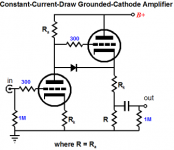audiowize said:Anybody have any clue what the plate dissipation is on these tubes? I've never found it on any datasheets....
These look to be small signal types, and I'd keep the Pd below about 1200mW.
I have looked for this as well and like you never found a rating. I have used 76's and 37's and always kept the dissipation at 1 watt or less with no problem.
I read that they work better with grid bias, but I've had great results with cathode bias. They also work well as the bottom tube in a mu follwer configuration.
Good luck!
I read that they work better with grid bias, but I've had great results with cathode bias. They also work well as the bottom tube in a mu follwer configuration.
Good luck!
I think that most of these tubes will be limited by filament emission rather than plate dissipation. Most of the 30's that I have tested start to saturate at 30 to 50 mA and have gone nonlinear well before that. Granted all of mine are very old and very used. I just got a few 27's at a hamfest, but haven't tried them yet.
After MUCH searching
Pa Max for 56 = 1.3W
Pa Max for 76 = 1.4W
Could not find ANYTHING for 27/37 but would guess as another poster said about 1.2W.
By doing some "Forensic Acounting" I was able to justify going to say 1.4W on the 37/27.
By using spec's from same issue of Cunningham/RCA manuals I noticed that wherever I could get a PaMax rating for a specific tube and I compared that to the highest plate voltage spec the Operating point was always 88% of Pa Max. So extrapolating about 110% of the 250Vp idle current spec I get about 1.4.
Hope this helps, these tubes do not have much Mu anyway so stick with the 1.2W on all of them. There aren't many of these around.
BTW, I have a few of each in pretty good shape..interested?
Pa Max for 56 = 1.3W
Pa Max for 76 = 1.4W
Could not find ANYTHING for 27/37 but would guess as another poster said about 1.2W.
By doing some "Forensic Acounting" I was able to justify going to say 1.4W on the 37/27.
By using spec's from same issue of Cunningham/RCA manuals I noticed that wherever I could get a PaMax rating for a specific tube and I compared that to the highest plate voltage spec the Operating point was always 88% of Pa Max. So extrapolating about 110% of the 250Vp idle current spec I get about 1.4.
Hope this helps, these tubes do not have much Mu anyway so stick with the 1.2W on all of them. There aren't many of these around.
BTW, I have a few of each in pretty good shape..interested?
I got some 56's I was going to use for a gain stage in front of my buffer. How would these work as a Anode follower directly coupled to a 5687 cathode follower? Or maybe 2 56's in a CCD grounded cathode amplifier like this?
Attachments
Sylvania Technical Manual 1943:
http://www.bunkerofdoom.com/tubes/syl43/data/1943/1943.htm
http://www.bunkerofdoom.com/tubes/syl43/data/1943/1943.htm
I just got a few 27's at a hamfest, but haven't tried them yet.
I guess my memory isn't what it used to be. I got some 26's (DHT) at a recent hamfest (cheap too). No tube time since then though.
Thanks for all the info guys! I have about 100 globe 27's, probably 200-300 ST 27's, three globe 37's, twelve globe 56's, and a healthy smattering of ST 37's, 76's, 56's, and 27's. I tend to like the way they sound (like the Tung Sol round plate 6SN7) and they aren't really that hard to implement. Well, back to the preamp project!
I use transformer coupled 26s in my line amplifier. (For about the last 8yrs) Quite pleased with the overall performance. 27 sound quite nice too, but the very early ones at least seem to experience cathode to filament insulation breakdown issues particularly with cathode bias. I run the 26 and 27 typically at 150V and 6mA, and the 01A at 130 - 150V @ 3mA. I prefer the DHTs for no particular logical reason other than they are way more reliable and less microphonic (but not that much less) than most 27s I have encountered.
I generally use fixed bias with these early types and fortuitously in the case of all types mentioned a 9V transistor radio battery provides just about the right level of negative grid bias for a reasonable operating point. These types generally generate a uA or less of grid current in operation which is not a problem for the battery. Battery life will be about the shelf life of the battery.
I generally use fixed bias with these early types and fortuitously in the case of all types mentioned a 9V transistor radio battery provides just about the right level of negative grid bias for a reasonable operating point. These types generally generate a uA or less of grid current in operation which is not a problem for the battery. Battery life will be about the shelf life of the battery.
- Status
- This old topic is closed. If you want to reopen this topic, contact a moderator using the "Report Post" button.
- Home
- Amplifiers
- Tubes / Valves
- 27/37/56/76 plate dissipation
